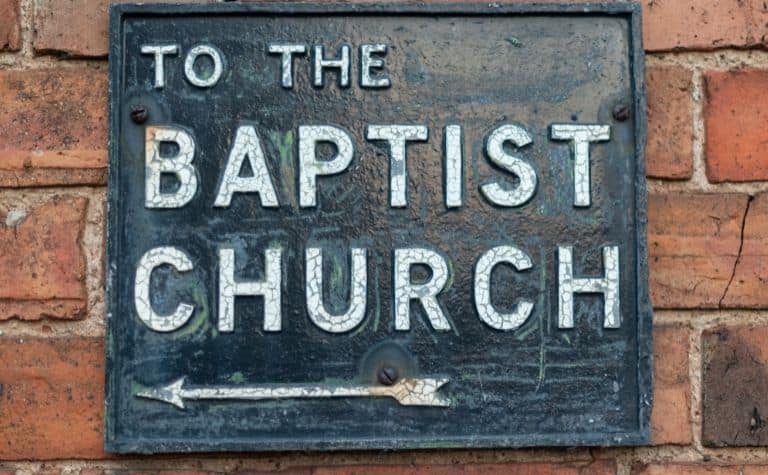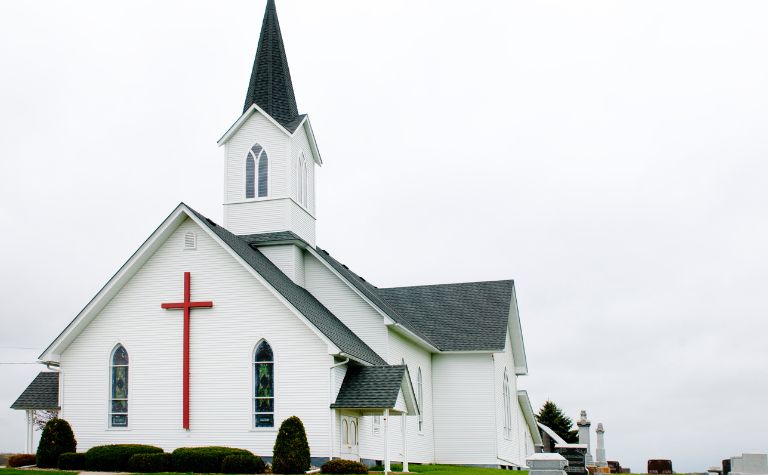Many people know that the names “Protestant” and “Baptist” are both related to Christianity. Yet with so many names, titles, and terms associated with denominations and churches, it can be difficult to know the difference between them.
“Protestant” describes the movement that started in 16th-century Europe, which rebelled against certain teachings and practices of the Roman Catholic church. “Baptist” is a type of Protestant tradition that dates to 16th-century England that champions adult baptism and congregational church government.
How do the Protestant and Baptist movements’ origins, beliefs, and worldviews compare? What are the largest Protestant denominations? What are the largest Baptist denominations? Keep reading to learn more.
Also, see Protestant vs. Orthodox vs. Catholic: Compared to learn more.

Protestant and Baptist Overview: Similarities and Differences
Because the Baptist tradition is a part of Protestantism, there is significant overlap in their stories and convictions. However, though all Baptist denominations and churches are Protestant, not all Protestants are Baptist. (Also see Protestant vs Pentecostal: What’s the Difference?)
| Protestant | Baptist | |
|---|---|---|
| Name | The word “Protestant” comes from the Latin word protestari, meaning “to bear witness.” | The word “Baptist” comes from the practice of “believer’s baptism,” i.e. only professing Christians are baptized, not infants |
| Origin | 16-century Europe, especially Germany, under the reforms of Martin Luther (1483-1546) | The Baptist tradition has roots in English Puritanism and the Anabaptist tradition in Europe. |
| Early influencer(s) | Martin Luther, John Calvin of France (1509-1564), and Ulrich Zwingli of Switzerland (1484-1531) | John Smyth (1554-1612) in England, Roger Williams in America (1603-1683) |
| Significant writing outside the Bible | Writings and sermons of Martin Luther, especially the 95 Theses, Calvin’s The Institutes of the Christians Religion, and many others. | The London Confession of Faith (1689), the New Hampshire State Baptist Convention (1832) |
| What are the largest denominations in the tradition today? | Southern Baptist Convention, the United Methodist Church, the Evangelical Lutheran Church of America, and the Assemblies of God (see more below) | Southern Baptist Convention (SBC); National Baptist Convention, USA, Inc. (NBCUSA) |
| Primary doctrine | Salvation is by grace through faith in Christ alone; the five solas (“sola” means “only”): Scripture alone, faith alone, grace alone, Christ alone, to the glory of God alone. | Since the Baptist tradition is Protestant, it traditionally adheres to the same core convictions expressed in the five solas. |
| Theology | Protestants can be Calvinist, Arminian, or Baptist. They can be Pentecostal or not. | The Baptist tradition is one of the most doctrinally diverse denominations in Protestantism (e.g., Baptists may be Calvinist or Arminian); Baptists generally agree on Believer’s Baptism, the autonomy of the local church, and the separation of church and state. |
| Theological and Social worldview | Protestants may be liberal or conservative theologically or socially. | It depends on the denomination; the Southern Baptist Convention is theologically and socially conservative; others, like American Baptists Churches (USA), welcome liberal and progressive ideas and practices. |
The Protestant movement has generated hundreds of denominations in the last 500 years. Because there is no central church or authority figure like in Catholicism, people have extraordinary freedom to start new denominations and churches. (Also, see Protestant vs. Eastern Orthodox: What’s the Difference?)
Planting churches in countries that have religious freedom, like the United States, also multiplies the number of denominations and churches that are started. Here are the Top 10 Protestant denominations by size:
- Southern Baptist Convention
- United Methodist Church
- National Baptist Convention, USA
- Evangelical Lutheran Church in America
- Assemblies of God
- National Missionary Baptist Convention in America
- African Methodist Episcopal Church
- Baptist General Conference of Texas
- Lutheran Church-Missouri Synod
- Episcopal Church
To discover the top 100 Protestant denominations according to size (with statistics), please see The Largest Protestant Denominations: The Top 100.

Theology in the Protestant and Baptist Traditions
All Protestants have the same core convictions on doctrines like the inspiration and authority of Scripture, the Trinity, and the Second Coming of Christ. (Also, see Protestant vs. Non-Denominational: What’s the Difference?)
As the table below illustrates, Protestant denominations like Baptist, Methodist, Lutheran, Episcopalian, Presbyterian, Assemblies of God, and others, sometimes have unique views on doctrines of secondary importance.
| Protestantism | Baptist Tradition | |
|---|---|---|
| Scripture | One of the hallmarks of Protestant tradition is the authority of Scripture over and above church tradition. Protestants historically believe in the inspiration and authority of Scripture. | As an expression of Protestantism, the Baptist tradition has the same historic convictions as the wider Protestant tradition. |
| God | Protestants believe in the Trinity, one God who exists in three persons. The Father, Son, and Holy Spirit are each fully divine. | Baptists also believe in the Trinity and that each person is fully God. |
| Christ | Jesus is the second person of the Trinity. He is God in human flesh. He is 100% God and 100% man. Jesus was born of a virgin, lived a sinless life, died as an atonement for sin, and was physically resurrection on the third day. | Baptists historically believe the same truths about Christ. |
| Holy Spirit | The Holy Spirit is the third person of the Trinity. He is fully divine. The Spirit applies the salvation that the Father planned and that the Son earned for sinners. He bestows spiritual gifts on believers that they are to use for the edification of the Church. | Baptists historically believe the same truths about the Holy Spirit. |

| Protestantism | Baptist Tradition | |
|---|---|---|
| Salvation | Protestants believe that salvation is by grace through faith in Christ alone. | Baptists hold to the same mantra and truths it conveys. |
| Sacraments | Unlike Catholicism, Protestants believe there are two sacraments: water baptism and the Lord’s Supper. Protestants do not always agree on who should be baptized or the nature of the bread and cup. | There are two: Believer’s Baptism (but not infant baptism) and the Lord’s Supper. The bread and cup are memorials. |
| Church organization | Protestant churches can be organized in different ways, such as congregationalism, presbyterianism, or episcopalianism. | Baptist churches are congregational, which means the decision-making power resides in the congregation. The autonomy of the local church is an important Baptist doctrine. Local churches often belong to denominations, associations, or networks, but their relationship is cooperative. |
| View of the end times | Protestant churches may be Premillennial, Postmillennial, or Amillennial. | Some Baptists are Amillennial. Others are Premillennial. A small number are Postmillennial. |
Also, see Protestant vs. Anglican: What’s the Difference?
The seven largest Baptist denominations are:
- Southern Baptist Convention
- National Baptist Convention, USA
- National Missionary Baptist Convention in America
- Baptist General Conference of Texas
- American Baptist Churches in the USA
- Cooperative Baptist Fellowship
- Progressive National Baptist Convention, Inc.
Please see the related articles below.
References:
[1] Source
[2] Source
[3] Source
Related Questions
Catholic vs. Protestant vs. Orthodox: What's the Difference?
Roman Catholicism, Protestant Christianity, and the Eastern Orthodox Church are the three historical branches of the Christian religion. Each tradition traces its doctrines and practices to the New...
Protestantism and Anglicanism are branches of the Christian faith that have roots in Europe. Protestantism and Anglicanism have similarities and differences with each other as well as other...
